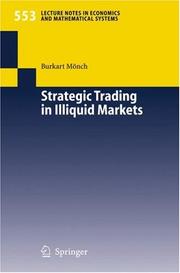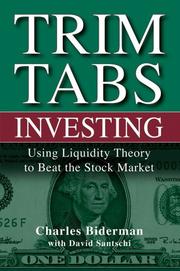| Listing 1 - 10 of 92 | << page >> |
Sort by
|
Book
ISBN: 0128038268 0128037687 9780128038260 9780128037683 Year: 2016 Publisher: Amsterdam, [Netherlands] : Academic Press,
Abstract | Keywords | Export | Availability | Bookmark
 Loading...
Loading...Choose an application
- Reference Manager
- EndNote
- RefWorks (Direct export to RefWorks)
Securities --- Transaction costs --- Liquidity (Economics) --- Mathematical models. --- Assets, Frozen --- Frozen assets --- Finance --- Cost --- Externalities (Economics) --- Right of property --- Stochastic orders --- Ordres stochastiques
Book
ISBN: 9781119990246 1118652258 1118818466 1119990661 Year: 2013 Publisher: Chichester Wiley
Abstract | Keywords | Export | Availability | Bookmark
 Loading...
Loading...Choose an application
- Reference Manager
- EndNote
- RefWorks (Direct export to RefWorks)
A fully up-to-date, cutting-edge guide to the measurement and management of liquidity riskWritten for front and middle office risk management and quantitative practitioners, this book provides the ground-level knowledge, tools, and techniques for effective liquidity risk management. Highly practical, though thoroughly grounded in theory, the book begins with the basics of liquidity risks and, using examples pulled from the recent financial crisis, how they manifest themselves in financial institutions. The book then goes on to look at tools which can be used to measure liquidity risk, discussing risk monitoring and the different models used, notably financial variables models, credit variables models, and behavioural variables models, and then at managing these risks. As well as looking at the tools necessary for effective measurement and management, the book also looks at and discusses current regulation and the implication of new Basel regulations on management procedures and tools.
Liquidity (Economics) --- Bank liquidity --- Financial risk --- Risk management --- Assets, Frozen --- Frozen assets --- Finance --- Insurance --- Management --- Business risk (Finance) --- Money risk (Finance) --- Risk --- E-books --- Private finance
Book
ISBN: 1606927752 1617285323 9781617285325 9781606927755 9781606927755 Year: 2009 Publisher: New York
Abstract | Keywords | Export | Availability | Bookmark
 Loading...
Loading...Choose an application
- Reference Manager
- EndNote
- RefWorks (Direct export to RefWorks)
Banks and banking. --- Interest rates. --- Liquidity (Economics). --- Liquidity (Economics) --- Interest rates --- Banks and banking --- Agricultural banks --- Banking --- Banking industry --- Commercial banks --- Depository institutions --- Money market rates --- Rate of interest --- Rates, Interest --- Assets, Frozen --- Frozen assets --- Finance --- Financial institutions --- Money --- Interest
Book
ISBN: 383491004X 3834999555 Year: 2008 Publisher: Wiesbaden : Gabler Edition Wissenschaft,
Abstract | Keywords | Export | Availability | Bookmark
 Loading...
Loading...Choose an application
- Reference Manager
- EndNote
- RefWorks (Direct export to RefWorks)
Real estate, private equity, arts, and even wine are gaining increasing popularity as capital investments. Attractive risk-return profiles and high diversification potentials make them valuable additions to investment portfolios. Their main drawback, however, is the low level of liquidity. Such assets cannot be bought or sold quickly without compromising large portions of their value. Despite its high practical relevance, this issue has so far received only little attention from researchers. Jaroslaw Morawski offers a practicable and theoretically well-founded solution to the problems encountered when investing in illiquid assets. Building on the Theory of Search, the author develops a model of the liquidation process for this category of investments. He uses the model to propose a number of methods for measuring liquidity, optimizing exit strategies, and allowing for liquidity in the traditional mean-variance portfolio selection. The result is a coherent investment decision framework designed specifically for private real estate but applicable also to other illiquid assets.
Liquidity (Economics) --- Real estate investment. --- Assets, Frozen --- Frozen assets --- Finance. --- Macroeconomics. --- Economics. --- Macroeconomics/Monetary Economics//Financial Economics. --- Finance, general. --- Investment in real estate --- Real property investment --- Investments --- Land speculation --- Real estate business --- Finance --- Funding --- Funds --- Economics --- Currency question
Book
ISBN: 9519109021 Year: 1976 Publisher: Helsinki Finnish economic association
Abstract | Keywords | Export | Availability | Bookmark
 Loading...
Loading...Choose an application
- Reference Manager
- EndNote
- RefWorks (Direct export to RefWorks)
Finance --- -Money --- -Business enterprises --- -Liquid assets --- -Liquidity (Economics) --- -Assets, Frozen --- Frozen assets --- Near money --- Money --- Business organizations --- Businesses --- Companies --- Enterprises --- Firms --- Organizations, Business --- Business --- Currency --- Monetary question --- Money, Primitive --- Specie --- Standard of value --- Exchange --- Value --- Banks and banking --- Coinage --- Currency question --- Gold --- Silver --- Silver question --- Wealth --- Funding --- Funds --- Economics --- Mathematical models --- -Mathematical models --- Liquidity (Economics) --- Business enterprises --- Liquid assets --- Mathematical models. --- Assets, Frozen --- Finance&delete&

ISBN: 1280459565 9786610459568 3540263152 3540250395 Year: 2005 Publisher: Berlin ; New York : Springer,
Abstract | Keywords | Export | Availability | Bookmark
 Loading...
Loading...Choose an application
- Reference Manager
- EndNote
- RefWorks (Direct export to RefWorks)
The Area of Research and the Object of Investigation In this thesis we will investigate trading strategies in illiquid markets from a market microstructure perspective. Market microstructure is the academic term for the branch of financial economics that investigates trading and the organization of security markets, see, e. g. , Harris (2002). Historically, exchanges evolved as a location, where those interested in buy ing or selling securities could meet physically to transact. Thus, traditionally security trading was organized on exchange floors, where so-called dealers arranged all trades and provided liquidity by quoting prices at which they were willing buy or sell. Consequently, the initial surge of the market mi crostructure literature focused predominantly on this type of market design, which is often referred to as quote-driven. Nowadays, the interest is shifting towards order-driven markets. Beginning with the Toronto Stock Exchange in the mid 1970s and increasing in fre quency and scope, this market structure has emerged as the preeminent form of security trading worldwide. In order-driven markets, exchanges arrange trades by matching public orders, often by employing automatic execution systems. Introduction A major difference between a quote-driven and an order-driven market arises from the transparency pre- and post-trade. The pre-trade transparency con cerns the question whether the order book is visible to the keeper only, or whether it is open to the public.
Stocks --- Liquidity (Economics) --- Options (Finance) --- Derivative securities --- Prices --- Mathematical models. --- Assets, Frozen --- Frozen assets --- Finance --- Finance. --- Macroeconomics. --- Finance, general. --- Quantitative Finance. --- Macroeconomics/Monetary Economics//Financial Economics. --- Economics --- Funding --- Funds --- Currency question --- Economics, Mathematical . --- Mathematical economics --- Econometrics --- Mathematics --- Methodology --- Social sciences --- Financial Economics. --- Mathematics in Business, Economics and Finance. --- Macroeconomics and Monetary Economics. --- Mathematics.
Book
ISBN: 3835095773 3835007556 Year: 2007 Publisher: Wiesbaden : Deutscher Universitats-Verlag,
Abstract | Keywords | Export | Availability | Bookmark
 Loading...
Loading...Choose an application
- Reference Manager
- EndNote
- RefWorks (Direct export to RefWorks)
Most market places in today’s exchange industry operate on fully electronic trading systems. The predominant form of trading systems is the open limit order book pooling all buy and sell limit orders in one single order book. The attractiveness of an order book is determined by its liquidity. Consequently, liquidity is the competitive factor for an exchange. However, it is not the exchange that provides the liquidity but the limit orders standing in the order book. The question is: Who are these traders that provide liquidity on a voluntary basis? A high frequency transaction data set for the German equity market is the basis for Alexandra Hachmeister’s extensive empirical analysis. This includes a detailed market description of the German equity market, a new methodological approach for the identification of informed traders and finally the analysis of the individual liquidity providing and demanding behavior of the identified informed traders. Questioning the existing theoretical literature on liquidity provision in equity markets, she finds strong evidence for liquidity providing behavior of informed traders.
Liquidity (Economics) --- Stock exchanges --- Econometric models. --- Research --- Bulls and bears --- Commercial corners --- Corners, Commercial --- Equity markets --- Exchanges, Securities --- Exchanges, Stock --- Securities exchanges --- Stock-exchange --- Stock markets --- Capital market --- Efficient market theory --- Speculation --- Assets, Frozen --- Frozen assets --- Finance --- Finance. --- Finance, general. --- Funding --- Funds --- Economics --- Currency question

ISBN: 0471697206 9786610255115 1280255110 0471726389 9780471726388 9780471697206 Year: 2005 Publisher: Hoboken, N.J. : Wiley,
Abstract | Keywords | Export | Availability | Bookmark
 Loading...
Loading...Choose an application
- Reference Manager
- EndNote
- RefWorks (Direct export to RefWorks)
Whether you are an investment professional managing billions of dollars or an individual investor with a small nest egg, TrimTabs Investing shows you how to beat the major stock market averages with less risk. This groundbreaking book begins by comparing the stock market to a casino in which the house (public companies and the insiders who run them) buys and sells shares with the players (institutional and individual investors). TrimTabs Investing argues that stock prices are primarily a function of liquidity-the amount of shares available for purchase and the amount of money
Liquidity (Economics). --- Stocks - United States. --- Stocks. --- Stocks --- Liquidity (Economics) --- Investment analysis. --- Stock exchanges --- Analysis of investments --- Analysis of securities --- Security analysis --- Assets, Frozen --- Frozen assets --- Common shares --- Common stocks --- Equities --- Equity capital --- Equity financing --- Shares of stock --- Stock issues --- Stock offerings --- Stock trading --- Trading, Stock --- Finance --- Securities --- Bonds --- Corporations --- Going public (Securities) --- Stock repurchasing --- Stockholders --- Investment analysis --- E-books
Book
ISBN: 3834918229 9786613560582 1280382678 3834985546 Year: 2009 Publisher: Wiesbaden : Gabler,
Abstract | Keywords | Export | Availability | Bookmark
 Loading...
Loading...Choose an application
- Reference Manager
- EndNote
- RefWorks (Direct export to RefWorks)
Internal liquidity models for banks have gained considerable importance since German regulators have decided to accept them for regulatory reporting. Christian Schmaltz identifies product cash flows, funding spread, funding capacity, haircuts, and short-term interest rates as key liquidity variables. Then, he assumes specific stochastic processes for the key variables leading to a particular liquidity model. The modelling focus lies on the product cash flow that is described by a jump-diffusion process. Finally, the author applies the model to the allocation, internal pricing, and optimization of liquidity.
Bank liquidity. --- Bank management. --- Risk management. --- Finance --- Business & Economics --- Banking --- Finance - General --- Investment & Speculation --- Liquidity (Economics) --- Banks and banking. --- Business. --- Trade --- Agricultural banks --- Banking industry --- Commercial banks --- Depository institutions --- Assets, Frozen --- Frozen assets --- Finance. --- Finance, general. --- Economics --- Management --- Commerce --- Industrial management --- Financial institutions --- Money --- Funding --- Funds --- Currency question
Book
ISBN: 0199324093 9780199333059 019933305X 9780199324095 9780199936243 0199936242 Year: 2013 Publisher: New York Oxford University Press
Abstract | Keywords | Export | Availability | Bookmark
 Loading...
Loading...Choose an application
- Reference Manager
- EndNote
- RefWorks (Direct export to RefWorks)
The way in which securities are traded is very different from the idealized picture of a frictionless and self-equilibrating market offered by the typical finance textbook. This book offers a more accurate and authoritative take on liquidity and price discovery.
Liquidity (Economics) --- Securities --- Capital market --- Capital markets --- Market, Capital --- Finance --- Financial institutions --- Loans --- Money market --- Crowding out (Economics) --- Efficient market theory --- Blue sky laws --- Capitalization (Finance) --- Investment securities --- Portfolio --- Scrip --- Securities law --- Underwriting --- Investments --- Investment banking --- Assets, Frozen --- Frozen assets --- Law and legislation --- E-books --- Securities. --- Capital market.
| Listing 1 - 10 of 92 | << page >> |
Sort by
|

 Search
Search Feedback
Feedback About UniCat
About UniCat  Help
Help News
News